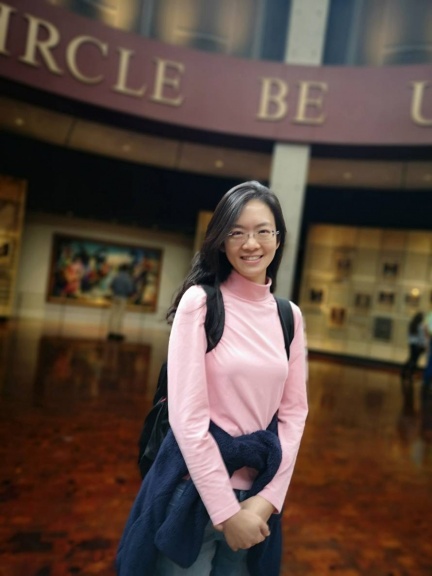Spotlight on Chris Lindsell
Professor Chris Lindsell, who leads the ACTIV-6 Data Coordinating Center, was featured in the February 11 issue of the ACTIV-6 Site Newsletter, which is published twice a month by Duke Clinical Research Institute. The interview is republished here with permission.
What is your role on ACTIV-6? I am privileged to lead the Data Coordinating Center. Our team has developed an innovative way of running studies by using the research record like the medical record. The data we collect includes a mix of the information we need to find out what medicines help patients feel better faster, and all of the data needed for real time study information sharing and communications. The partnership with DCRI has allowed us to create a fully integrated system that will continue to get better as we learn from this new way of doing studies.
What activities or hobbies do you enjoy outside of work? I used to play rugby, but then I blew out my knees. Then I used to sail, but there isn’t much water in Nashville. I took up gardening but my brown thumb left me with little hope. For a while, I was a craft beer brewer and home vintner, which also had bad side effects. Pandemic isolation gave me a whole new lease on life and I got to teach myself the guitar while smoking bacon, chicken, salmon, turkey, brisket, cheese, bread, and even vegetables. This year I plan to master the art of pastry (or patience, or both).
Why do you think ACTIV-6 is important? If there is a safe medicine already available that could help people feel better faster from Covid-19, I want to know that, I think that’s important.
What drives and motivates you about working on the ACTIV-6 study? The challenge of finding a way to do research in totally different ways and solving the problem of what medicines help people feel better faster drives me. The passion, dedication, and excellence of the teams that are leading this research motivate me.
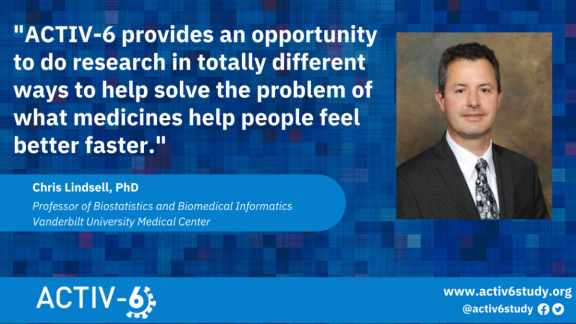
Spotlight on Savannah Obregon
Application developer Savannah Obregon was featured in the January 28 issue of the ACTIV-6 Site Newsletter, which is published twice a month by Duke Clinical Research Institute. Her contributions to the study range from front-end presentations to back-end programming, including displays of study data on the Support Site landing page, the site's FAQ, the creation of a back-up server for emergency randomization, and auto-generating alerts. As stated in the issue, "her work is invaluable to site enrollment and the smooth operation of the study as a whole."
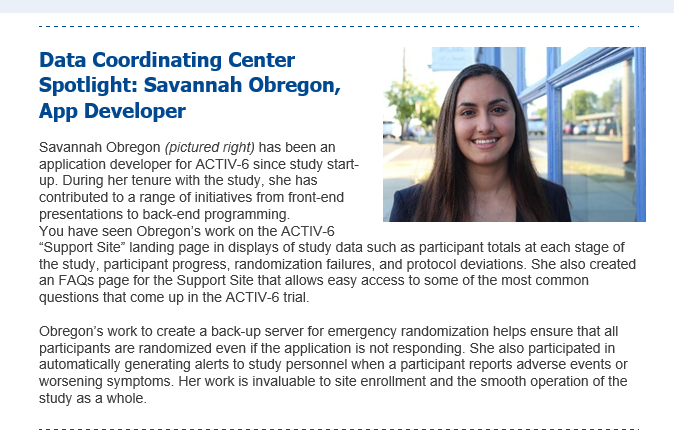
To date, the ACTIV-6 research study has enrolled more than three thousand participants. To learn more about the quest to help people with COVID-19 feel better faster, visit activ6study.org.
(Spotlight republished here with permission.)
Cancer-Immu: a new data portal for research and treatment
Click the link to read the feature in the January 14 VUMC Reporter.
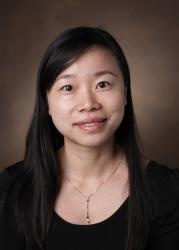
Celebrating ACTIV-6 and IVY
Happy 2022, y'all! At the end of 2021, members of the Vanderbilt ACTIV-6 and IVY teams gathered online to celebrate the work they've collectively achieved in collaboration. Department members in the below gallery include Chris Lindsell, Wu Gong, Samuel Nwosu, Matt Shotwell, Yuwei Zhu, Zhouwen Liu, Dean Gibson, and Kim Hart.
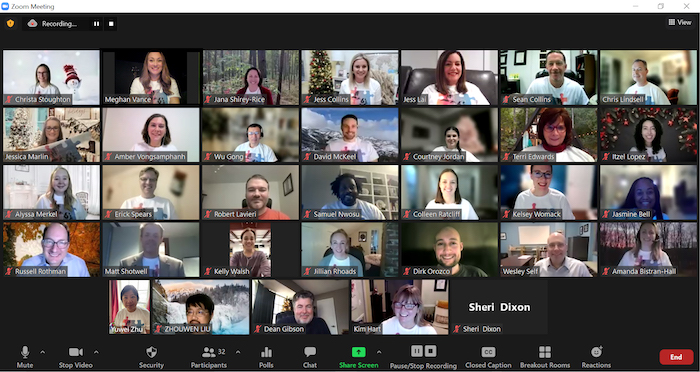
You can see most of the attendees wearing a t-shirt with a logo symbolizing the integration of the teams' expertise and dedication. The logo was designed by program manager Meghan Vance.
Vanderbilt University Medical Center houses the Data Coordinating Center for the national ACTIV-6 drug repurposing trials. Dr. Lindsell heads the DCC as its principal investigator, with department members Frank Harrell and Tom Stewart among its co-investigators. For more about the medical center's role with ACTIV-6, see this November VUMC Reporter feature.
The Influenza and Other Viruses in the Acutely Ill (IVY) Network has more than 11,000 critically ill people enrolled in its COVID-19 surveillance studies to date. Recent publications include "Association Between mRNA Vaccination and COVID-19 Hospitalization and Disease Severity," presented in the November 4 issue of JAMA.
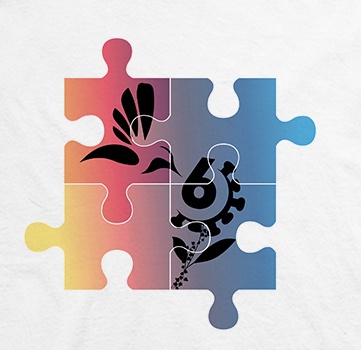
Fighting drug resistance and other threats with GAIHN
Department chair Yu Shyr and vice chair of informatics and collaborative programs Lynne D. Berry are on a team newly funded by the Centers for Disease Control and Prevention (CDC) to combat infectious threats throughout the world. Read more about the Medical Center's role with the Global Action in Healthcare Network in the December 7 VUMC Reporter.
Shyr and Berry are also directors of Vanderbilt's Center for Quantitative Sciences, which provides biostatistical support, expertise, and training to researchers both in Nashville and around the world. Visit the CQS Statistical Data Centers page for some of the collaborations CQS members have helped facilitate and implement.
Vanderbilt Biostatistics Bulletin - November 2021 issue
The November 2021 issue of our department newsletter is now available. We are excited about our many projects and programs in progress.
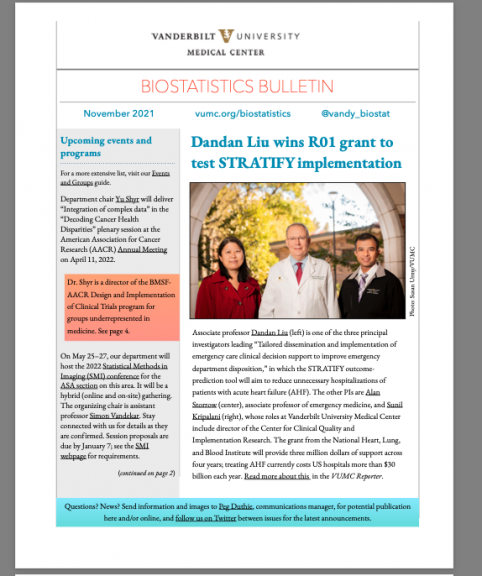
Molecular Mapping
The current issue of Vestigo, the Vanderbilt Basic Sciences magazine, includes a feature on human cell atlases being created by VUMC researchers, including associate professor Qi Liu and department chair Yu Shyr. Read about these ambitious projects via the web version of the feature or one of Vestigo's other formats (accessible screen-reader-friendly PDF or ISSUU).
Left to right: Qi Liu, Lori Coburn, Gregor Neuert, Keith T. Wilson, Ken Lau, and Bennett Landman. Photo by Joe Howell/Vanderbilt University.
Department Awards
Last month's all-department meeting included an award ceremony, during which vice chair of research Jonathan Schildcrout and graduate program director Robert Greevy presented the following honors:
The Linda Stewart Applied Analysis Report Award recognizes an exceptional applied analysis report written by a staff biostatistician in our department. The 2020 award was presented to Josh DeClercq for "Healthcare Costs and Utilization Project."
The IT Innovation Award recognizes exceptional work from a member or members of our IT team and potentially the team they work with. It celebrates the creative and crucial contribution that IT members make to department operations, and to the research program within the department, across the medical center, and more broadly. The 2020 award was presented to Cole Beck, Leena Choi, Elizabeth McNeer, Nathan James, Hannah Weeks, and Michael Williams, for the dose-building EHR (electronic health record) R package they authored.
The Patrick G. Arbogast Collaborative Publication Award recognizes an exceptional collaborative publication from a biostatistician or team of biostatisticians in our department. The 2020 award was presented to William D. Dupont and Dale Plummer for "8q24 Genetic Variation and Comprehensive Haplotypes Altering Familial Risk of Prostate Cancer," which was published in Nature Communications.
The Methods Publication Award recognizes an exceptional methodological publication from a biostatistician or team of biostatisticians in our department. The 2020 award was presented to Ran Tao for "Optimal Designs of Two-Phase Studies," which was published in Journal of the American Statistical Association.
The Distinguished Teaching Assistant Award, recognizing excellence in teaching and a dedication to peer education, was presented to Yan Yan.
The W. S. Gosset Award for Exceptional Research, recognizing exemplary work that will advance the field and impact of biostatistics, was presented to Yuqi Tian.
The Commodore Award in Biostatistics was presented to Coleman Harris in recognition of his altruistic dedication to enriching the department and graduate program.
The Outstanding Faculty Mentor Award, recognizing excellence in dedicated mentoring, with an altruistic commitment to student learning beyond the classroom, was presented to Simon Vandekar.
The Golden Apple Award for Excellence in Teaching was presented to Andrew Spieker in recognition of his altruistic commitment to student classroom learning.
There were many outstanding nominees, and we thank the judges: Dan Ayers, Svetlana Eden, Shawn Garbett, Robert Greevy, Frank Harrell, Bob Johnson, Orun Onur, Dale Plummer, Jonathan Schildcrout, and Matt Shotwell.
We will be sharing news of more awards in a few days. Stay tuned . . .

New Biostatistics students in Nashville
The fall semester has begun, and these ten brilliant, engaging individuals are the newest students in our graduate program. Here are a few details about their studies, careers, and interests. We are very much looking forward to learning and working with them!
Nate Dowd
BS, Biology, Colby College (statistics minor)
After graduating from Colby, Nate worked as a data analyst intern at GlaxoSmithKline, where he developed statistical models for analyzing consumer healthcare data. Some of his interests outside of the classroom include tennis, fantasy sports, traveling, and cooking.
Yeji Ko
BS, Statistics, University of Michigan
Yeji (rhymes with "veggie") grew up in Seoul, Korea. In Ann Arbor, she became interested in biostatistics and learned how to survive in cold weather. In her spare time, she loves traveling, exploring new places, and having great conversations over delicious meals.
Lan Shi
MS, Applied Statistics, University of Michigan
BS, Statistical Science, Chinese University of Hong Kong
Lan's research interest lies mainly in the application of machine learning to biomedical imaging data and wearable health device data analysis. She enjoys travel, hiking, music and, during the pandemic, easy dance workouts at home.
Joshua Slone
MS, Applied Economics, Johns Hopkins University
BA, Modern Middle Eastern Studies, University of Pennsylvania
Joshua is originally from Tampa, Florida. His path to biostatistics began in 2016 when he joined an expert witness group quantifying healthcare fraud at the US Department of Justice (DOJ). He worked on matters ranging from over-prescribing to unnecessary hospice services. For such cases, he designed statistical samples and analyzes/merges claims data, electronic health records (EHRs), and internal company sources. Joshua is eager to transition from retrospectively analyzing the worst of healthcare to building predictive models to improve human health.
Jared Strauch
BS, Biology, University of Wisconsin-Madison
Jared is originally from Minnesota. After graduating from Wisconsin, Jared spent a few years studying adherens junctions in C. elegans and then joined the lab management team at Exact Sciences, where he became deeply interested in the statistical methods that led to the development of Cologuard and other cancer screening technologies. His main interest is in statistical genetics, with an emphasis on biomarker discovery. Outside of work, he enjoys playing volleyball, board games, and hiking with my dog, Cooper.
Megan Taylor
BPH, Public Health, University of Kentucky (mathematics minor)
During college, Megan worked for the Kentucky Violent Death Reporting System as a data abstractor, constructing case narratives for homicides, suicides, and undetermined deaths. She is passionate about data-driven public health improvements and mental health, which she would love to incorporate into her work. In her personal life, she is an avid board game fan, reader, and geocacher.
Julia Whitman
MS, Epidemiology, Imperial College London
MA, University of St. Andrews
Julia's career in public health research started at Imperial College London, where she focused on chronic disease and cancer epidemiology. During her studies, she also edited regional HIV prevention proposals in Eastern Europe and the Balkans for the United Nations Development Program. She has since worked an intern at the Fred Hutchinson Cancer Center, clinical trials coordinator in the gastrointestinal oncology department at the University of California, San Francisco (UCSF), and data manager and clinical research analyst for UCSF’s Center for Neuroendocrine Tumors, where she enjoyed collaborating with an interdisciplinary team to answer questions in areas ranging from genomic medicine and survival analysis to in-clinic quality improvement.
Bailu (Lucy) Yan
MS, Applied Statistics and Data Analytics, Southern Methodist University
BS, Finance, Central University of Finance and Economics (Beijing)
Lucy most recently worked as a research assistant in the Department of Chemistry at Vanderbilt University, focusing on data-driven methodologies for biomolecular discovery. Before coming to Nashville, she worked in industry as a data analyst for two years, where she developed competency in both statistical research and real-world applications. Knowing the huge potential of statistical solutions in biomedicine and biological research, she's enthusiastic about embarking on an academic path toward solving open challenges in human health and diseases treatments.
Lydia Yao
BS, Data Science and Mathematical Statistics, Purdue University
While studying data science, Lydia developed an interest in statistical methods and modeling within health and medicine. She grew up in Indiana and enjoys playing piano, guitar, and clarinet. Competitive swimming has been a big part of her life, and she still occasionally swims for exercise. She enjoys solving sudoku puzzles and cooking different cuisines.
Elisa Yazdani
BA, Chemistry and Psychology, Washington & Jefferson College (mathematics minor)
Elisa is originally from North Carolina. Over the course of three internships - one at Vanderbilt and two at Duke - she worked on a variety of projects, studying neurodevelopment in animals, cognitive diseases, electrophysiology, and the impacts of drugs. “Paternal THC Exposure in Rats Causes Long-Lasting Neurobehavioral Effects in the Offspring,” a paper on one of her projects at Duke, was published in the Neurotoxicology & Teratology Journal. Her interests include pharmacokinetics, electrophysiology, cognitive disorders, and clinical trials. In her free time, she enjoys watching classic movies, sports, working out, and cooking.

BACK: Lydia Yao, Yeji Ko, Megan Taylor, Julia Whitman, Elisa Yazdani
To view a larger version of this photo, click the "Graduate Program" link near the top of this page.
Spotlight on Vanderbilt Biostatistics: Pei-Ying (Emily) Lin
This week’s spotlight series features Dr. Pei-Ying (Emily) Lin, a visiting scholar from the National Taiwan University Hospital in Taipei City, Taiwan. She is a specialist in pulmonary and critical care medicine, focusing on thoracic oncology. Her research interests include translational cancer research, data science, and precision medicine in cancer treatment.
What have been the major findings so far in your research? What could be the impact?
My major research field is lung cancer, the leading cause of cancer-related death worldwide. The driving force of lung cancer oncogenesis varies over different subtypes. My research topics primarily focus on dissecting mechanisms in order to develop therapeutics for current unmet needs. For example, CNS penetration, drug resistance, and poor response to immune checkpoint blockades in driver mutation positive cases.
What lessons have you learned throughout your career? How have these lessons drawn you to Vanderbilt?
After years of training in many topics, from clinical medicine to translational cancer research, I am a strong proponent for the importance of data science in this new era of medicine. High-dimensional data - whether structural or non-structural, genomics, proteomics, radiomics, or medical records - are becoming the core of modern medical research. Data integration and elaboration based on solidified analytical and verification processes and clinical experiences are now common practice. These are the reasons I am here at Vanderbilt – to further develop my understanding of data science and precision medicine.
What is your philosophy about research?
My philosophy about research is to discover the undiscovered etiology and/or mechanism of an unsolved problem, which can be a biological phenomenon or a disease, and to be honest and respectful to the data and findings. One should always integrate and interpret data properly, so that the research findings can make good to what inspires us to initiate the research project in the first place.
What are your thoughts on the debate between modern data science and traditional statistical practices?
The increasing importance of data science in the biomedical field is clear. Its application is most successful with strong teamwork and collaboration between data scientists and other researchers. Working to incorporate new techniques will only improve health and research outcomes.
Tell us about your life outside of Vanderbilt.
While my professional life keeps me very busy, I try to maintain my hobbies in music and arts. I enjoy listening to music and exercising to stay healthy and balance my work and life.
